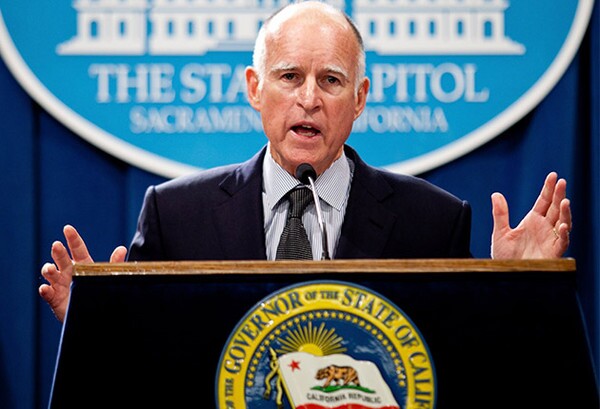Governor's Address Long on Climate, Short on Energy

California Governor Jerry Brown's State of the State address Thursday morning included a detailed, hard-headed assessment of the threat climate change poses to the state. It was a sobering description -- especially by comparison to President Obama's more general remarks during his Second Inaugural on Monday. But those looking for hints about new state energy policies for 2013 likely came away disappointed.
The Governor's remarks on climate change and energy came toward the end of his address. Here's the transcript of his prepared remarks, courtesy SoCal Connected, with some ReWire analysis mixed in:
When we think about California's future, no long term liability presents as great a danger to our well-being as the buildup of carbon dioxide and other greenhouse gases in the atmosphere.
According to the latest report from the World Bank, carbon dioxide emissions are the highest in 15 million years. At today's emissions rate, the planet could warm by more than 7 degrees Fahrenheit by the end of the century, an event unknown in human experience. California is extremely vulnerable because of our Mediterranean climate, long coastline and reliance on snowpack for so much of our water supply.
The last sentence here was a bit of shorthand that may bear explanation. Our Mediterranean climate and long, dry summer bring the risk of wildfire, which will likely be exacerbated if summers get hotter and thunderstorms more frequent. The state's more than 840 miles of coastline makes us vulnerable to sea level changes. Sea level is expected to rise several feet by the end of the century. And the fact that much of California derives its water supply from snowpack, in the Sierra Nevada and the Colorado River basin, makes us vulnerable to either decreased precipitation or a shift from snow to rain.
The Governor continued:
Tipping points can be reached before we even know we have passed them. This is a different kind of challenge than we ever faced. It requires acting now even though the worst consequences are perhaps decades in the future.
Again California is leading the way. We are reducing emissions as required by AB 32 and we will meet our goal of getting carbon emissions to 1990 levels by 2020.
AB 32, the Global Warming Solutions Act of 2006, also requires reporting of greenhouse gas emissions and enables the state's pioneering carbon credit auction mechanism.
The Governor then made an interesting choice of emphasis that's too often downplayed in discussions of more climate-friendly energy paths: conservation.
Key to our efforts is reducing electricity consumption through efficiency standards for buildings and appliances. Over the last three decades, these pioneering efforts have saved Californians $65 billion dollars. And we are not through yet.
It's estimated that Americans could conserve approximately a third of the energy they now use by taking advantage of straightforward, readily-available means -- everything from replacing older appliances and lighting to turning lights off when not in use and lowering thermostats a degree or two. Californians use around half the energy per capita that Americans do as a whole; some of this stems from our relatively benign climate, but some of the savings have been reached by way of legislation and by changes in personal habits. It's telling that Brown called out conservation so prominently: it's a strength of California's already robust climate policy and it deserves attention and expansion.
We are also meeting our renewable energy goals: more than 20 percent renewable energy this year. By 2020, we will get at least a third of our electricity from the sun and the wind and other renewable sources--and probably more.
Governor Brown ad-libbed a bit after delivering these two sentences, going off-script to note that the executives of California's utilities had called this accomplishment impossible. Aside from four words in a sweeping summary of 2012's accomplishments at the start of the speech, they were the only mention of renewable energy in his address Thursday. There was no mention of state initiatives such as the Desert Renewable Energy Conservation Plan to manage utility-scale energy development of our landscape, or the California Solar Initiative to build generating capacity in our urban areas. This sole mention of energy was as a back-pat for the state in meeting the requirements of the Renewable Portfolio Standards, without actually mentioning those standards by name.
In truth, there's one climate-related aspect of the Governor's address that will likely attract far more attention than anything energy-related: Brown's proposal for a "Peripheral Tunnel" to protect the state's water distribution system from possible sea level rise overwhelming the Sacramento Delta:
If because of an earthquake, a hundred year storm or sea level rise, the Delta fails, the disaster would be comparable to Hurricane Katrina or Superstorm Sandy: losses of at least $100 billion and 40,000 jobs. I am going to do whatever I can to make sure that does not happen. My proposed plan is two tunnels 30 miles long and 40 feet wide, designed to improve the ecology of the Delta, with almost 100 square miles of habitat restoration. Yes, that is big but so is the problem.
Brown has been pushing for a conveyance to bring water from the Sacramento River to Southern California, bypassing the fragile Delta, since his first stint as Governor in the late 1970s. A proposition that would have allowed the construction of the notorious Peripheral Canal was soundly defeated in 1982, mainly due to intense opposition in Northern California. It remains to be seen whether Brown's Peripheral Tunnel, which he's been pushing since taking office again in 2011, will be any more popular.


